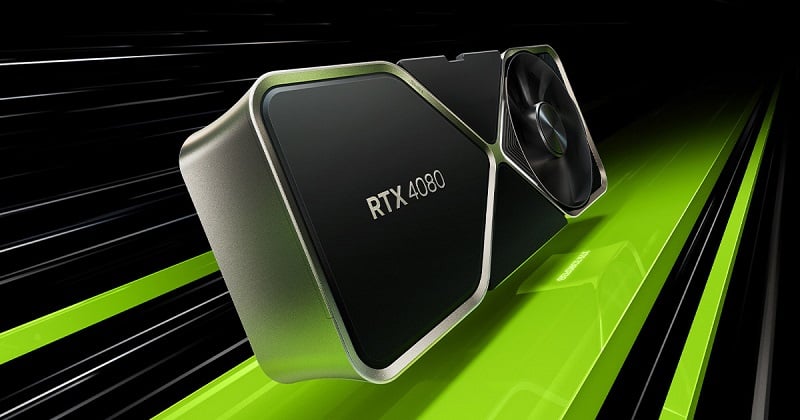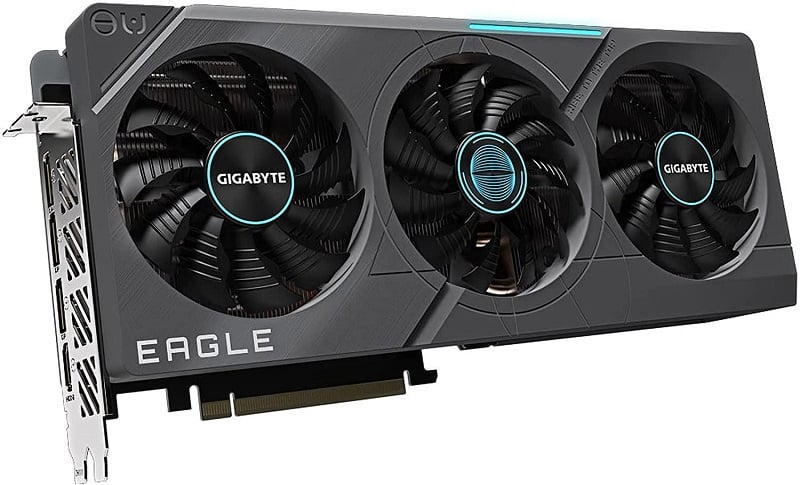Nvidia’s RTX 40-series graphics cards are some of the best GPUs you can buy today. And that’s true whether you’re gaming at 4K with all the settings turned up to their highest, or more interested in high frame rate 1440p play. The latest addition to this family of super-powered graphics cards is the RTX 4070 Ti – hot off the presses after its CES 2023 reveal.
While there is some competition from AMD’s latest RX 7000 graphics cards, if you’re an Nvidia fan, the RTX 4080 and 4070 Ti are staunch competitors for your money. They both offer excellent new-generation performance, come with very capable cooling solutions, and give you access to the latest generations of ray tracing acceleration and deep learning super sampling; including the new DLSS 3.0 frame generation technology.
If you’re trying to decide which of Nvidia’s new high-end GPUs are for you, here’s a look at what these two cards have in common, and what sets them apart.
Just an RTX 4080 vs 4080? What’s in a name

The elephant in the room with Nvidia’s RTX 4080 and 4070 Ti, is that one of these cards was always named this way, and the other only came to it recently. You may have heard rumours of Nvidia “unlaunching” a card, or that the 4070 Ti is a rebrand of some other card; and that’s right, to an extent.
At Nvidia’s RTX 40-series unveiling, it debuted the flagship RTX 4090, a second-step RTX 4080 16GB, and the more modest, RTX 4080 12GB. Due to pushback from fans, Nvidia quietly pulled the RTX 4080 12GB from launch, and instead focused on the newly non-qualified RTX 4080 (with 16GB of memory), and the RTX 4090.
Now we have the RTX 4070 Ti, a card with specs identical to that of the unlaunched RTX 4080 12GB.
So yes, we’ve seen this GPU before, but no, it isn’t just a rebrand. This card no longer has a reference edition, so there is no Nvidia 4070 Ti GPU, and it’s cheaper, too. While there is never a guarantee with third-party board partner pricing, we do know that the cooling should be improved over even Nvidia’s impressive solution, so the RTX 4070 Ti should be slightly better than the planned RTX 4080 12GB.
That won’t necessarily make it the better buy, here, but it’s important to be clear that the 4070 Ti is more than just a rebadged 4080 12GB. But how much more? Let’s find out.
Nvidia RTX 4080 vs. 4070 Ti Specifications
| Nvidia GeForce RTX 4080 | Nvidia GeForce RTX 4070 Ti | |
| Process node | TSMC 4nm | TSMC 4nm |
| CUDA cores | 9728 | 7680 |
| Ray tracing cores | 76 3rd-gen | 60 3rd-gen |
| Tensor cores | 304 4th-gen | 240 4th-gen |
| Base clock | 2,205MHz | 2,310MHz |
| Maximum clock | 2,505MHz | 2,610MHz |
| Memory size | 16GB GDDR6X | 12GB GDDR6X |
| Memory speed | 21Gbps | 21Gbps |
| Memory bus | 256-bit | 192-bit |
| Bandwidth | 717 GBps | 504 GBps |
| TDP | 320 watts | 285 watts |
The Similarities and Differences
The RTX 4080 and RTX 4070 Ti are both based on the same Ada Lovelace architecture and are built on the same 4nm process node. They both support the same generations of RT core and tensor core too, but their core counts are quite distinct across the board, despite their proximity in the lineup of Nvidia’s new GPUs.
The RTX 4080 has close to 27% more CUDA cores than the RTX 4070 Ti, which should contribute to a notable increase in overall performance. That same disparity is found with the RT and Tensor Cores, too, which should give the RTX 4080 an advantage in a whole host of games where ray tracing and DLSS are available.
However, the RTX 4070 Ti does benefit from the latest generations of both core types, so should be able to hold its own against older cards from Nvidia and AMD’s previous generations.
Clock speeds are quite typical of modern GPUs, with the RTX 4070 Ti able to hold slightly higher boost and base clocks due to its lower CUDA core count. However, on the memory front, it falls significantly behind. Not only does it have four gigabytes less memory overall, but it has a constricted memory bus, which severely limits memory bandwidth to just 504 GBps.
That’s still a lot of bandwidth, but the RTX 4080 has over 50% more, and with 16GB, it is much more future-proofed against next-generation games.
That said, where Nvidia typically targets its XX80 range of GPUs at 4K play, the xx70-series Nvidia graphics cards are often more targeted towards 1440p play at high frame rates. And in that respect, 12GB shouldn’t be too much of a bottleneck in the years to come.
How fast are they really?

Specifications only tell us part of the story when it comes to comparing graphics cards. To get the full picture, we need to take a look at how these cards perform in the real world, and with plenty of reviews of Nvidia’s new RTX 4070 Ti now out in the wild, we have plenty of data to go over to figure out just how good these two cards are, and how they compare.
Synthetic benchmarks like 3DMark give us a good general idea of their performance, with the RTX 4080 scoring around 25,000 points in Time Spy when paired with a powerful CPU and memory combination. In comparison, the RTX 4070 Ti manages just over 21,500 points – an impressive score that puts it ahead of every last-generation card from Nvidia and AMD, but not enough to compete directly with the RTX 4080.
Port Royal, the ray-tracing-centric 3DMark benchmark is a more interesting story, however.
The RTX 4080 is still the definitive winner, with a score of around 18,000 points, while the RTX 4070 Ti manages just over 14,000 points. That’s a solid score in a very demanding benchmark, but what’s intriguing is how much the 4070 Ti pulls ahead of the last-generation cards – really showing the benefit of its new RT and Tensor cores.
Those cores also help it compete directly with the more expensive AMD RDNA3 graphics cards in ray tracing, so you need to bear that in mind if you’re considering a team red GPU too.
Real world gaming performance: 4080 vs 4070 Ti
What about real games? Those can behave quite differently to synthetic benchmarks, and many of them demand more than even the most stringent of synthetic tests. The story here is similar, but as we suspected, it’s different depending on the resolutions we run the tests at.
In 4K, where these kinds of next-generation GPUs can really stretch their legs, it’s clear that the RTX 4080 is the more capable graphics card. Indeed it typically pulls ahead of any card that isn’t the RTX 4090, although AMD’s top alternatives do give it a run for its money.
In Cyberpunk 2077, where the RTX 4080 manages to average a frame rate just shy of 60 FPS, the RTX 4070 Ti can only manage 45 FPS. This is with all the settings at Ultra, but with ray tracing disabled – turning it on with everything else maxed out is something only really reserved for the RTX 4090.
At that kind of frame rate, we’d probably feel the need to lower some settings to improve performance, as 60 FPS is typically considered the minimum for a smooth gaming experience; even if 30 FPS is often touted as a perfectly fine, cinematic experience.
4K vs 1440p
Switch to 1440p, though, and it’s a different story. With the same Ultra settings and ray tracing disabled, the RTX 4070 Ti manages over 95 FPS on average. The RTX 4080 still manages more, with an average of around 115 FPS, but that’s a much narrower gap than at 4K.
We can see a similar trend in other demanding games, too. In Gears Tactics, the RTX 4080 achieves an impressive frame rate of 104 FPS at 4K resolution with Ultra High settings, while the 4070 Ti hits a respectable 79 FPS average. Tone down the resolution to 1440p, though, and the RTX 4080 only maintains a small lead over the 4070 Ti. It hit 190 FPS on average, but the RTX 4070 Ti managed 157 FPS.
That’s a gap of over 31% frames per second at 4K, but only a 21% difference at 1440p. Some of that is likely because the RTX 4080 is held back by its CPU at that more-limited resolution, but it further enhances the idea that the RTX 4070 Ti is the better value card for 1440p gaming, while the 4080 is a more viable 4K card.
In Forza Horizon 5, the RTX 4080 managed 135 FPS at 4K and 164 FPS at 1440p, while the RTX 4070 Ti is almost neck and neck, managing 115 FPS and 163 FPS, respectively.
It’s clear that the RTX 4080 is the better card, but it’s not always by as much as you might think, and the gap is far closer at 1440p.

Ray tracing
While the RTX 4070 Ti does occasionally trade performance blows with last-generation cards like the RTX 3080 in general rasterization, once you turn on ray tracing the new-gen RT cores really show their worth.
In Far Cry 6 with all the settings turned to Ultra, including ray tracing, at 4K resolution the RTX 4070 Ti tears ahead of the RTX 3080 by over 30 percent. The RTX 4080 is still ahead, but only by about 15%, highlighting how well the 4070 Ti manages this demanding lightning technique.
In F1 22 with ray tracing enabled and Ultra High settings, at 4K, the RTX 4080 gets very close to a 60 FPS average, while the RTX 4070 Ti is just under 50 FPS. While that may be another case of it being recommendable to bring the 4070 Ti PC down to 1440p for better performance, it absolutely blows away last-generation cards, and AMD’s best, highlighting how the new Lovelace cards are still leaps and bounds ahead in ray tracing.
Deep Learning Super Sampling

DLSS has always been the better upscaling algorithm, but with the introduction of frame generation technology, that may be doubly true – at least until AMD and Intel can respond with their own versions of the technology. In the meantime though, the only way to experience this significant performance boost is with an RTX 40-series graphics card.
With new games like Plague Tale: Requiem and Marvel’s Spider-Man Remastered already using the technology to great effect, there’s an argument to be made that the best way to play these demanding games is with a 40-series GPU. You just cannot get the same performance with anything else.
The list is short for now, but there are 50-100% boosts in frame rates to be had when making use of this feature on top cards like these. While more effective on the RTX 4080, you may be able to opt for the RTX 4070 Ti and then use frame generation and DLSS 3 to boost your FPS to RTX 4080 levels. As this technology improves and becomes more ubiquitous, these more affordable cards start to look a lot more attractive.
Conclusion – this naming scheme is better
It would have been disingenuous for Nvidia to sell what has become the RTX 4070 Ti, as an RTX 4080. It’s clearly a more mid-range GPU that is best suited for high frame rate 1440p play, and that will only become more apparent as newer, more demanding games are released over 2023 and beyond.
The price drop from Nvidia – or at least the recommendation of one to board partners – is welcome, as the RTX 4070 Ti would have been a hard sell at its original, 4080 12GB price. It’s still arguably a little expensive for what you get – especially when last-generation GPUs are more affordable, so purely from a cost-to-performance perspective, the RTX 4080 does offer better value. Especially since it’s a more capable card that can unlock 4K resolution for you.
However, raw power is not the whole picture. The RTX 4070 Ti is still much cheaper than the 4080, and it gives you support for new technologies like DLSS 3 frame generation, and will likely make better use of Nvidia’s upcoming AI-enhanced drivers than last-generation cards. If you’re willing to spend RTX 4080 money too, it’s worth considering whether you shouldn’t just pay that bit more and get the 4090 instead, as it is a lot more powerful.
There’s also AMD’s competitive cards to consider too.
But if you are sat holding a 4070 Ti in one hand and an RTX 4080 in the other, wondering which to buy, then base it on the resolution you plan to play at. If you’re looking to game at 1440p and want new-gen power and features, the 4070 Ti is the card for you. If you want to game at 4K, though, especially if you want to do so in next-gen games, the RTX 4080 is by far the better buy.






